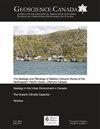Igneous Rock Associations 27. Chalcophile and Platinum Group Elements in the Columbia River Basalt Group: A Model for Flood Basalt Lavas
IF 0.8
4区 地球科学
Q3 GEOSCIENCES, MULTIDISCIPLINARY
引用次数: 1
Abstract
The Columbia River Basalt Group is the youngest and best preserved continental Large Igneous Province on Earth. The 210,000 km3 of basaltic lavas were erupted between 16.6 and 5 Ma in the Pacific Northwest, USA. The peak of the eruptions occurred over a 700,000-year period when nearly 99% of the basalts consisting of the Steens, Imnaha, Picture Gorge, Grande Ronde and Wanapum Basalts were emplaced. In this study we examined the Platinum Group Elements (PGEs) Pt and Pd, and the chalcophile elements Cu and Zn in the Columbia River Basalt Group. The presence of Pt, Pd and Cu in the compositionally primitive Lower Steens, Imnaha and Picture Gorge Basalts suggests that the Columbia River Basalt Group magma was a fertile source for these elements. The PGEs are contained mainly in sulphides in the earliest formations based on their correlation with immiscible sulphides, sulphide minerals and chalcophile elements. Grande Ronde, Wanapum and Saddle Mountains Basalts are depleted in PGEs and chalcophile elements compared to earlier formations. Sulphur was saturated in many flows and much of it probably came from assimilation of cratonic rock from a thinned lithosphere. We propose a model where the presence or absence of PGEs and chalcophile elements results primarily from the interaction between an advancing plume head and the crust/lithosphere that it encountered. The early lavas erupted from a plume that had little interaction with the crust/lithosphere and were fertile. However, as the plume head advanced northward, it assimilated crustal/lithospheric material and PGE and chalcophile elements were depleted from the magma. What little PGE and chalcophile elements remained in the compositionally evolved and depleted Grande Ronde Basalt flows mainly were controlled by substitution in basalt minerals and not available for inclusion in sulphides.火成岩协会哥伦比亚河玄武岩群中的亲铜和铂族元素:洪水玄武岩熔岩的一种模式
哥伦比亚河玄武岩群是地球上最年轻、保存最完好的大陆大火成岩省。在16.6至5 Ma之间,美国太平洋西北地区爆发了21万km3的玄武岩熔岩。火山爆发的高峰发生在70万年的时间里,当时几乎99%的玄武岩(包括Steens玄武岩、Imnaha玄武岩、Picture Gorge玄武岩、Grande Ronde玄武岩和Wanapum玄武岩)形成。本文研究了哥伦比亚河玄武岩群中铂族元素Pt、Pd和亲铜元素Cu、Zn。在组成原始的下斯廷斯、Imnaha和Picture Gorge玄武岩中存在Pt、Pd和Cu,表明哥伦比亚河玄武岩群岩浆是这些元素的丰富来源。与不混相硫化物、硫化物矿物和亲铜元素的对比表明,pge主要存在于最早地层的硫化物中。与早期地层相比,Grande Ronde、Wanapum和Saddle Mountains玄武岩的pge和亲铜元素含量已经减少。硫在许多流动中是饱和的,其中大部分可能来自于从变薄的岩石圈吸收的克拉通岩石。我们提出了一个模型,其中pge和亲铜元素的存在与否主要是由于前进的羽头与它所遇到的地壳/岩石圈之间的相互作用。早期的熔岩是从羽流中喷发出来的,羽流与地壳/岩石圈几乎没有相互作用,而且很肥沃。然而,随着地幔柱头向北推进,它吸收了地壳/岩石圈物质,岩浆中PGE和亲铜元素被耗尽。大龙德玄武岩流中残留的少量PGE和亲铜元素主要受玄武岩矿物取代控制,无法包裹在硫化物中。
本文章由计算机程序翻译,如有差异,请以英文原文为准。
求助全文
约1分钟内获得全文
求助全文
来源期刊

Geoscience Canada
地学-地球科学综合
CiteScore
3.30
自引率
0.00%
发文量
9
审稿时长
>12 weeks
期刊介绍:
Established in 1974, Geoscience Canada is the main technical publication of the Geological Association of Canada (GAC). We are a quarterly journal that emphasizes diversity of material, and also the presentation of informative technical articles that can be understood not only by specialist research workers, but by non-specialists in other branches of the Earth Sciences. We aim to be a journal that you want to read, and which will leave you better informed, rather than more confused.
 求助内容:
求助内容: 应助结果提醒方式:
应助结果提醒方式:


